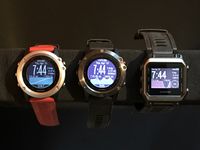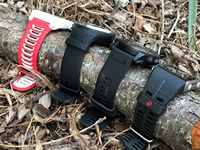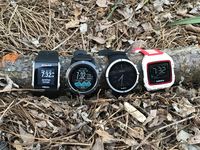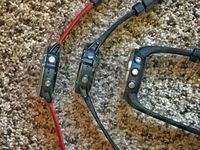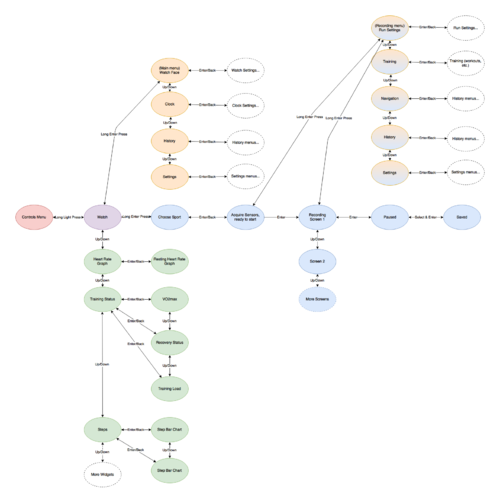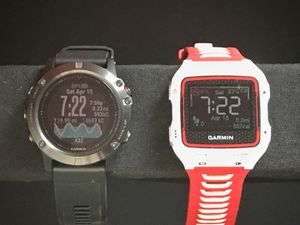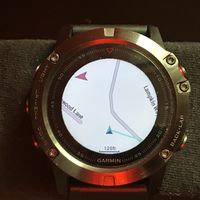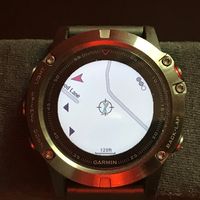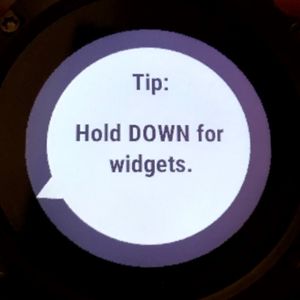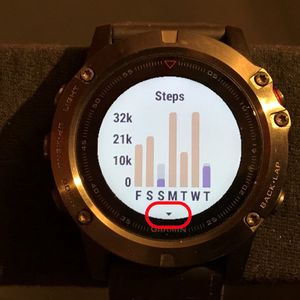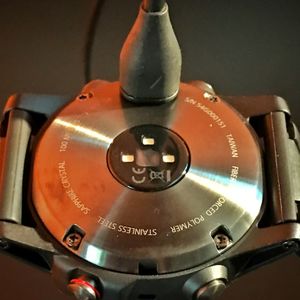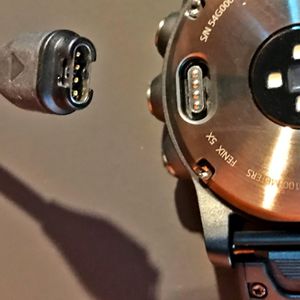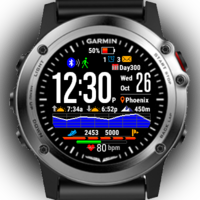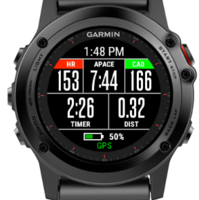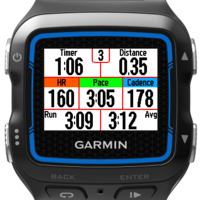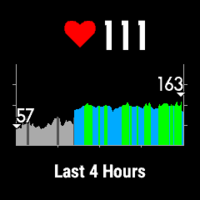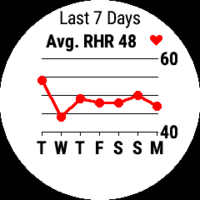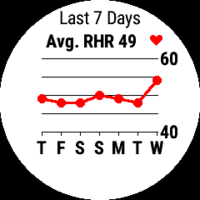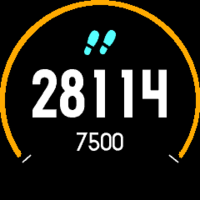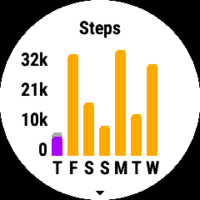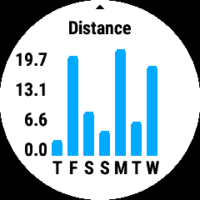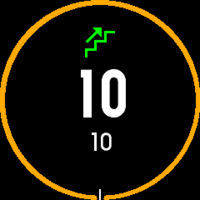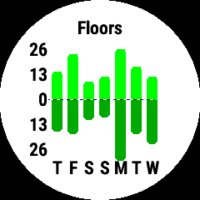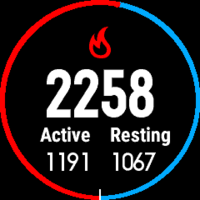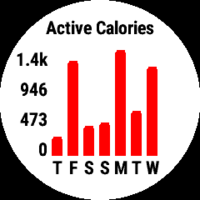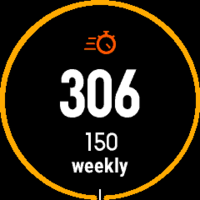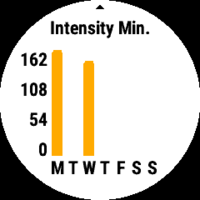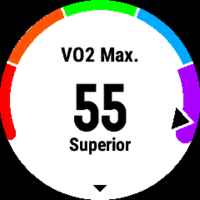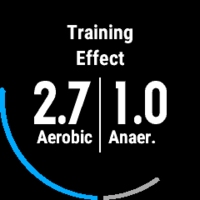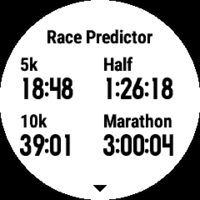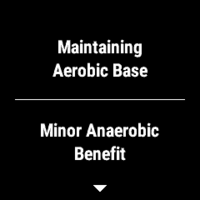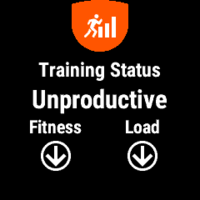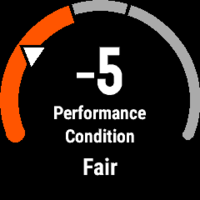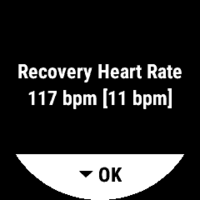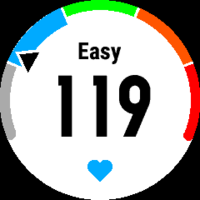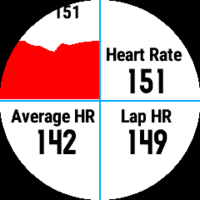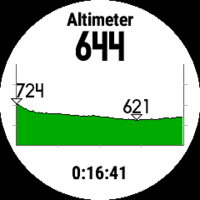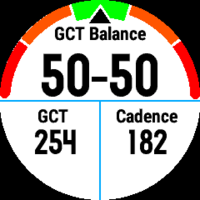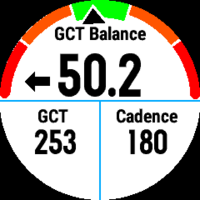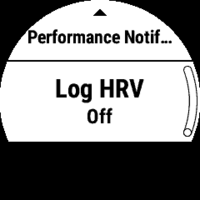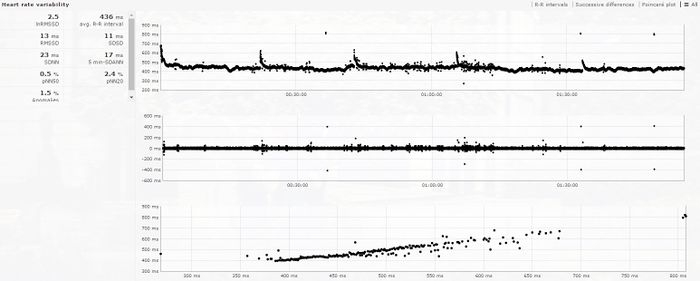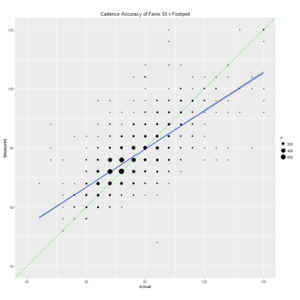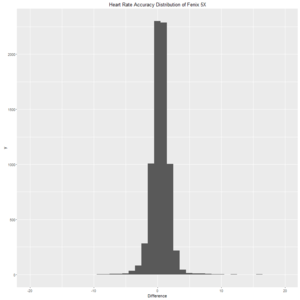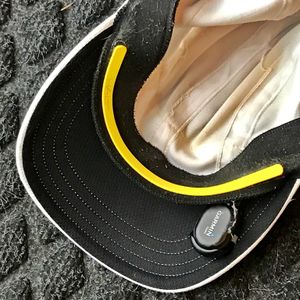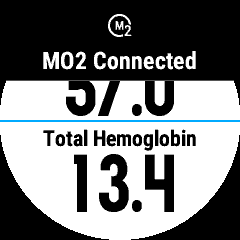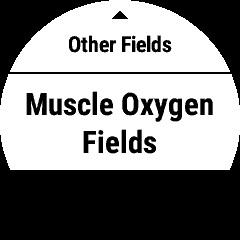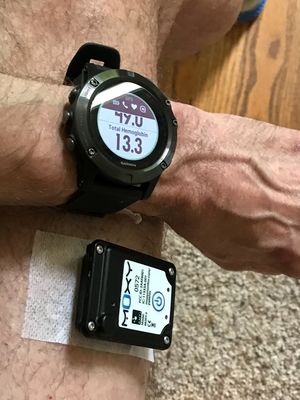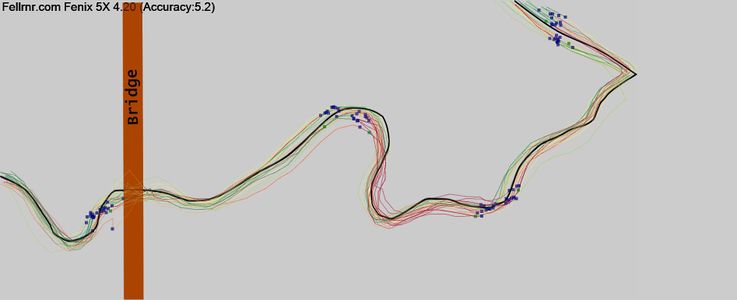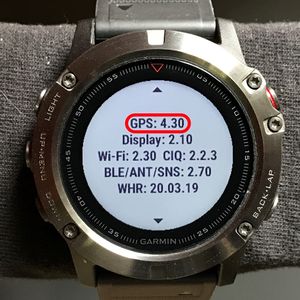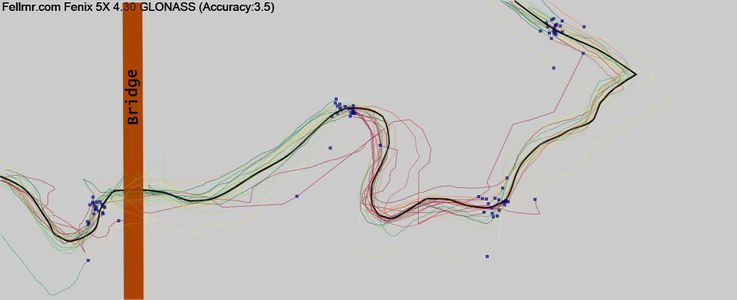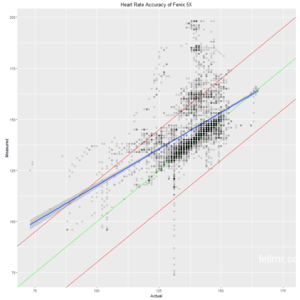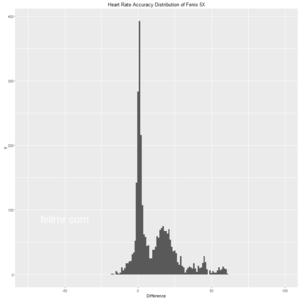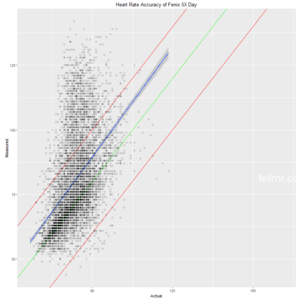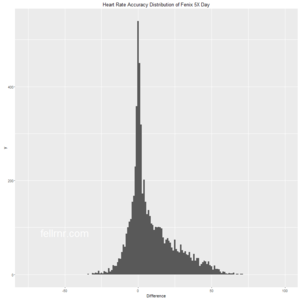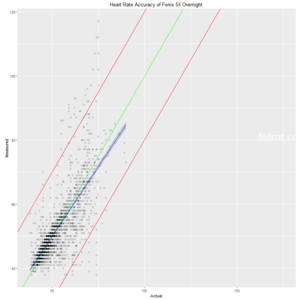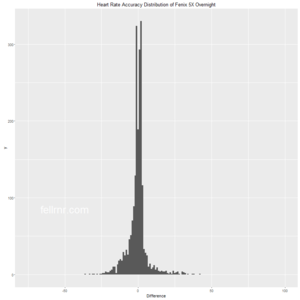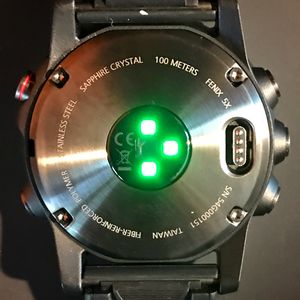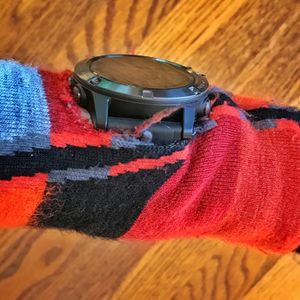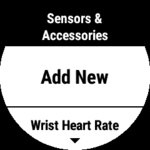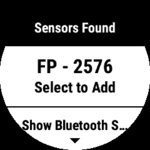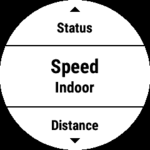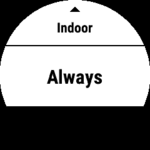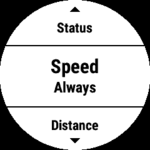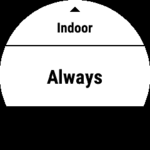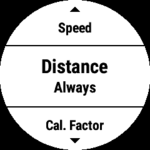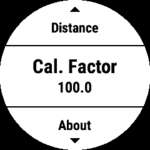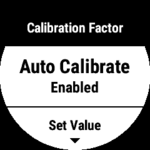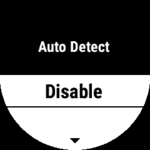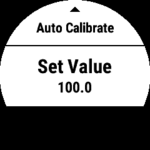Difference between revisions of "Garmin Fenix 5X"
User:Fellrnr (User talk:Fellrnr | contribs) |
User:Fellrnr (User talk:Fellrnr | contribs) m |
||
| Line 63: | Line 63: | ||
| <jfs id="B01N7J9APR" nonl="true"/> | | <jfs id="B01N7J9APR" nonl="true"/> | ||
| <jfs id="B01NBL9XGP" nonl="true"/> | | <jfs id="B01NBL9XGP" nonl="true"/> | ||
| − | | <jfs id=" | + | | <jfs id="B06XGD6CS4" nonl="true"/> |
|} | |} | ||
Within each model, there are choices of wristband type, with a metal wristband adding $150 and sapphire glass adding $100. There are also a number of color choices, though the 5X is only available in gray. So, which to buy? I'd recommend getting the [[Garmin 935]] as it's cheapest. The only reasons to buy the Fenix version are if you need the full color maps of the 5X. Of course, with the release of the Fenix 5, you can get the [[Garmin Fenix 3]] at a lower cost. The [[Garmin Epix]] is also worth considering as it has the maps of the 5X and most of the other functionality. | Within each model, there are choices of wristband type, with a metal wristband adding $150 and sapphire glass adding $100. There are also a number of color choices, though the 5X is only available in gray. So, which to buy? I'd recommend getting the [[Garmin 935]] as it's cheapest. The only reasons to buy the Fenix version are if you need the full color maps of the 5X. Of course, with the release of the Fenix 5, you can get the [[Garmin Fenix 3]] at a lower cost. The [[Garmin Epix]] is also worth considering as it has the maps of the 5X and most of the other functionality. | ||
Revision as of 04:28, 10 June 2017
The Garmin Fenix 5X is the top of the range of Garmin's running/outdoor watches. It has an impressive array of features, and it uses high quality materials to achieve a high-end look. It's only real weakness is its rather mediocre GPS accuracy, though this can be easily remediated by combining it with the Stryd. Of course, all this comes at a fairly hefty price, as the Fenix 5X retails for $700 (plus $200 for the Stryd.) Note: I've seen credible reports that the Fenix 5 and 5S models (but not the 5X or 935) have problems with their sensor support and I'd recommend avoiding those models until the issue is resolved.

| This review was made possible by readers like you buying products via my links. I buy all the products I review through normal retail channels, which allows me to create unbiased reviews free from the influence of reciprocity, or the need to keep vendors happy. It also ensures I don't get "reviewer specials" that are better than the retail versions.
|
Contents
- 1 Which Version?
- 2 The Big Questions
- 3 The Fenix 5X for Ultrarunning
- 4 Stryd Support
- 5 Physical Characteristics
- 6 User Interface
- 7 Charging and Syncing the Fenix 5X
- 8 Configuration
- 9 Connect IQ
- 10 Activity Tracking
- 11 Training Advice (Firstbeat)
- 12 Navigation
- 13 Sensor Support
- 14 GPS Accuracy
- 15 Optical Heart Rate Monitoring
- 16 Adding Stryd
- 17 Comparison Table
- 18 Navigation Features
1 Which Version?
There are four versions of the Fenix 5, one of which is branded as the Garmin 935. You can think of the 935 is a plastic bodied Fenix 5 for $100 less.
| Fenix 5X | Fenix 5 | Fenix 5S | Garmin 935 | |
|---|---|---|---|---|
| Size | 51mm/2.0" | 47mm/1.9" | 42mm/1.7" | 47mm/1.9" |
| Resolution | 240pixels | 240pixels | 218pixels | 240pixels |
| Display | 30mm/1.2 | 30mm/1.2" | 28mm/1.1" | 30mm/1.2" |
| Maps | Yes | No | No | No |
| MSRP | $700-850 | $600-850 | $600-850 | $500 |
| Battery | 20 Hours (35 UltraTrac) | 24 Hours (60 UltraTrac) | 14 Hours (35 UltraTrac) | 24 Hours (60 UltraTrac) |
| Lens | Sapphire Only | Glass or sapphire | Glass or sapphire | Glass |
| WiFi | Yes | With Sapphire | With Sapphire | Yes |
| Price | Error: Could not parse data from Amazon! | Error: Could not parse data from Amazon! | Error: Could not parse data from Amazon! | Error: Could not parse data from Amazon! |
Within each model, there are choices of wristband type, with a metal wristband adding $150 and sapphire glass adding $100. There are also a number of color choices, though the 5X is only available in gray. So, which to buy? I'd recommend getting the Garmin 935 as it's cheapest. The only reasons to buy the Fenix version are if you need the full color maps of the 5X. Of course, with the release of the Fenix 5, you can get the Garmin Fenix 3 at a lower cost. The Garmin Epix is also worth considering as it has the maps of the 5X and most of the other functionality.
There are credible reports that the smaller Fenix 5 and 5S models are having issues with sensor support. The reports suggest that Ant+ connectivity is poor, as well as some suggestions that the Bluetooth range is more limited than it should be.
2 The Big Questions
For a simple evaluation of a GPS watch, I look at how well it can answer some basic questions. There are many things a runner might look for in a running watch, but I feel these four questions are critical.
- How far did I run? This is the most basic question, and the Fenix 5X has rather mediocre GPS Accuracy. For me, this amount of error in the distance would be unacceptable. For instance, on a 20-mile Long Run you could see an error of nearly a mile, which is enough to really mess up your training. The good news is that the Fenix 5X has great support for the Stryd footpod that gives awesome accuracy.
- How fast am I running? Knowing how fast you're running can be a nice to know, or it can be vital for your training or race performance. Because of the nature of GPS, watches that rely on GPS signal alone tend to have serious problems with current pace. The poor GPS accuracy of Fenix 5X tends to exacerbate this, with readings fluctuating by over a minute/mile regularly and up to two minutes/mile occasionally. So, if you want pace information you need to get a Stryd footpod.
- Where am I? The Fenix 5X has about the best navigation options available. The headline feature is the full color, preloaded maps. On top of this, there is a breadcrumb display of where you've been, the ability to load predefined courses, navigation to waypoints, backtracking your course, a magnetic compass, and an altimeter. A larger display would be nice, and I'd love to have this functionality with the Suunto Spartan Ultra's high resolution display and touchscreen, or the Leikr's huge display, but the Fenix 5X does pretty well.
- What's my cadence? Cadence is one of the most critical and often overlooked aspects of running. If you get your Cadence right, many other things naturally fall into place. The Fenix 5X will get Cadence from its internal accelerometer, as well as from a Footpod, or the Running Dynamics heart rate strap/pod. There are alerts for Cadence, which is great, and even a metronome feature. I don't think it comes any better than this.
3 The Fenix 5X for Ultrarunning
The Fenix 5X claims 20 hours of battery life, and I tested it under optimal conditions and managed to get 23 hours. That's tough to achieve in the real world, as you have to avoid using the map display, backlight, or changing the display too often. With the map display in constant use, I was still able to achieve the rated 20 hours, which is pretty good. This makes the Fenix 5X a great candidate for shorter races (50 miles/100k). But if you hope to be still moving during the Second Dawn, then there are probably better options. You can charge the Fenix 5X on the run, but the position of the charging cable means you can't wear the watch while you're doing so (unlike the Garmin Fenix 3.) See Watches for Ultrarunning for more details.
4 Stryd Support
Main article: Stryd
As noted above, while the Fenix 5X has poor GPS accuracy, even the best GPS watch is still not good enough for accurate pacing. The answer currently lies with Stryd and extremely accurate Footpod that can measure distance and pace far better than GPS. The Fenix 5X has the best level of Stryd support, and will allow you to have all the accuracy of Stryd for pace and distance while having GPS active. This allows you to maintain all of the navigation features of the Fenix 5X, as well as recording a GPS track for later use. You can even get an estimate of your Running Power from Stryd via a Connect IQ data field. I'd strongly recommend getting a Stryd Footpod to go with your Fenix 5X. If that's too expensive, I'd argue that you're much better off getting the Stryd and saving money by getting a cheaper watch like the Garmin Fenix 3. For a walkthrough on adding Stryd, see the section towards the end of this article.
5 Physical Characteristics
The Fenix 5X is a big watch, and it's larger than I'm comfortable with as a 24 hour/day activity tracker. However, on the run it fells okay even on my diminutive wrists. The watch straps rotate where they connect to the watch body, unlike the Polar V800 where they extend from the watch body and therefore don't conform as well. The materials are excellent quality, and while it doesn't have the simplistic elegance of the Suunto Spartan Ultra it's still very nice. The exposed bolt heads make the Fenix 5 look rugged and sporty, though it's a bit fussy visually. The only thing that feels a little cheap and tacky is the watch strap itself on the cheapest version. It's nothing like the silky smooth and soft watch material that Suunto use (Garmin watch straps always seem poor to me.) I find the weight of the Fenix 5X to be quite intrusive at times. I suspect it's the combination of the size and weight, as the thickness of the watch puts some of the weight further away from your body. When I swap between the Fenix 5X and the 935, the weight difference is quite dramatic. The display is reasonable, but when you compare it to the Suunto Spartan Ultra it seems a little small and low resolution. Given that the Fenix 5X is larger than the Fenix 5, I would've expected a larger display, but that's not the case. I suspect that the Fenix 5X is larger to allow for more memory for the maps, or perhaps more battery, though this is purely speculation.
Left to right, Garmin Fenix 3, Fenix 5X, Garmin Epix, all having some of the best Stryd support.
Left to right, Garmin 920XT, Suunto Spartan Ultra, Fenix 5X, Polar V800, seen from above.
Left to right, Polar V800, Fenix 5X, Suunto Spartan Ultra, Garmin 920XT, all rather large watches.
Left to right, Suunto Spartan Ultra, Garmin Fenix 3, Fenix 5X.
Left to right, Fenix 5X, Garmin Fenix 3, Suunto Spartan Ultra.
6 User Interface
The Fenix 5X has the same user interface as many other higher end Garmin running watches. There is no touchscreen, but there are five real buttons that make the user interface fairly intuitive. Most navigation is done using the enter, up, down, and back buttons, with the common metaphor of moving in space between screens. The chart below is my representation of the Fenix 5X menu system. This only shows a tiny part of the overall menus, but hopefully it's enough to give you a sense of the way things fit together. In addition to the general up/down/left/right movement, there are various times when you need to do a long press a button to reach a menu.
I generally find this a clean and easy to use interface, though I know some folks prefer the 310XT/ 910XT/ 920XT style of interface that have buttons on the front surface rather than the sides.
Generally, I much prefer having real buttons to a touchscreen, as they are far easier to use with running. The only exception is when using a map display, where the ability to use multi-touch gestures such as pinching to zoom make things a whole lot easier.
One nice thing with the Fenix 5X (and a number of other Garmin watches) is that it will display some useful tips when you first start using it.
one pet peeve I have with the Fenix 5X user interface is the inconsistent use of visual clues. If you look at the image below, there is a small arrow at the bottom indicating you can go down for more data, but this is not applied consistently. Likewise, there is not a consistent hint to indicate there is more data if you hit enter.
7 Charging and Syncing the Fenix 5X
You can either sync the Fenix 5X using a USB cable to a computer, over Bluetooth to the smart phone app, or over WiFi. You have to use the USB cable for firmware upgrades and obviously, you have to use the cable for charging. The Fenix 5X connector is nicely designed, and is arguably how the USB connector should have been designed in the first place. Like Thunderbolt and USB-C, the Fenix 5X connector can be plugged in in either direction, so you don't waste your time repeatedly trying to work out which way round it goes. It's also very positive and stays in place nicely. The biggest downside, is that the position of the connector means you can't wear the watch while it's charging, unlike the Garmin Fenix 3.
Note that the Fenix 5X can be charged while recording, but the location of the charging port makes it difficult to Charge On The Run.
8 Configuration
Most of the configuration of the Fenix 5X is done directly in the watch, but there are aspects that have to be done via either the website, the smart phone app, or the PC (Garmin Express.) The main thing that you can't do on the watch itself is configure Connect IQ apps, watch faces, and data fields. The configuration on the watch is fairly intuitive, but the sheer number of configuration options can be a little bewildering, and if you have to do a factory reset, you have to apply all configuration changes again from scratch. While that's a bit of a pain, it's rarely a problem in practice, and more than made up for by the ability to configure the data shown during a workout without needing an Internet connection. Even better, you can configure the data shown during the workout actually during the workout itself. I find that surprisingly useful; just today it turned a little warm, and I was able to reconfigure my display to show the current temperature. It's not obvious (or it wasn't obvious to me) but you can copy a sports mode so that you can have multiple configurations for different types of work out. That way you can have a run based work out for easy runs, long runs, into full training, etc. this is rather nice, especially with the Stryd Footpod providing accurate pace information, which makes the pace alerts especially valuable. There is a limit that only allows two Connect IQ data fields, so having multiple workout types are allows you to have different combinations for different types of training.
9 Connect IQ
Main article: Connect IQ
Garmin's Connect IQ allows for the creation of apps to run on Garmin's running watches in much the same way you can run apps on Android or and iPhone. I've found the Connect IQ apps to be really valuable, and we're starting to see the number of apps explode, and the quality of the best apps has become remarkable. Many of the third-party apps are better than the Garmin developed apps, and significantly better than the built-in functionality. Below are two of my favorite watch faces, "ActiFace" and "GearMin" along with two of my favorite data fields "Single Field" and "Flexirunner".
I find myself using "Single Field" more often than any other. It puts a lot of data on the screen in a nice, usable fashion. There is a lot of customization with this data field, and the display uses color to show heart rate and cadence out of range. Search for "Single Field" by "lcj2" to find it.]]
As a tangent, Garmin gives us this heart rate graph widget, which color codes zone, shows heart rate, along with the minimum and maximum in the time window, so why can't we have something similar built in to the activity data screens?
10 Activity Tracking
The Fenix 5X has a similar activity tracking support to most of the rest of the range of recent Garmin watches. The biggest problem I find with the Fenix 5X is an activity tracker is simply its physical size and weight, and I'd much rather have a smaller watch for wearing 24 hours a day. You can get a lot of the activity tracker functionality on a much smaller device such as the Garmin Vivoactive or Garmin Vivoactive HR. The Fenix 5X will track various aspects of your daily activity:
- Workouts. Obviously, the Fenix 5X will track your runs, and will integrate that information into an overall picture of your daily activity levels.
- Steps. The step counting in the Fenix 5X is comparable to other devices. When you're walking or running its pretty accurate, but there are other situations where it's a genuinely ambiguous as to whether you are taking steps or not, such as preparing food in the kitchen. I found that the Fenix 5X recorded a very similar number of daily steps as other Garmin devices I wore on the other wrist, which gives me some confidence in their consistency at least.
- Floors Climbed. The Fenix 5X, along with a number of other recent Garmin watches, use the barometric altimeter to determine when you're going up or down steps. This is a rather nice idea, but the accuracy seems to be rather poor. I find the Fenix 5X will report a different number of steps ascended to descended, even though I've never used an elevator on those days. There's also a significant discrepancy between Garmin watches worn concurrently.
- Intensity minutes. It's not clear how Garmin calculates "intensity minutes", but it seems to use heart rate to determine intensity, with high levels of intensity counting as a multiplier on the actual number of minutes. I've seen some strange discrepancy in intensity minutes when using the optical heart rate monitor, which is not surprising given the accuracy issues. I suspect that changes in the heart rate zone also impact intensity minutes, but the lack of transparency in this calculation makes it hard to evaluate.
- Sleep. The estimation of sleep can be a little flaky on occasions, but overall it seems to do a reasonable job. It's hard to verify the estimation of sleep, other than checking if the bedtime and rising time seem reasonable. I'm not convinced by the Garmin estimate of how much deep and light sleep you are getting, and I tend to ignore that information as suspect. I have noticed that changing time zone can really mess up the sleep calculation, but hopefully Garmin will resolve this at some point.
- Resting Heart Rate. It uses two methods of detecting resting heart rate. If you wear the watch overnight with the OHRM enabled, it will be the lowest heart rate it sees while you're asleep. If not, then it will be the lowest one minute average it sees during the day. The value it records seems a little higher than I would expect, and I've seen some discrepancies when I'm wearing the Garmin 935 and the Fenix 5X concurrently. I keep an eye on the reported resting heart rate, as this is a potential red flag for Overtraining or other health problems, but I'd only be concerned if I see a consistent rise over several days.
- Move IQ. Garmin will estimate when you're performing an activity even if you've not explicitly recorded it. So, if I walk the dog, which I don't add to my training log, Garmin will automatically detect this as an activity.
- Feedback. The area where Garmin really shines as an activity tracker is the feedback and inspiration that they provide. The Connect IQ watch faces can provide an overview of your weekly activity and how today is comparing with other days, which I find is a good way of motivating myself to get moving. Watch faces also provide a progress bar for how close you are to your daily step goal, though I wish that they'd implement some way of seeing your continued progress after you've hit the goal. Some days I can reach several times in my minimum goal, and it would be nice to see this visually. There are also a number of firework displays the watch gives when you hit your goal. These little firework displays could be considered cheesy or annoying, but I found over time that I really appreciate the little bit of positive feedback. You can also get more information on your activity by scrolling through the widgets on the watch, as well as a vast array of information and visualization on both the Garmin Connect smart phone app and their website.
11 Training Advice (Firstbeat)
The Fenix 5X gives several types of training advice, and I'm rather skeptical as to their value. As George Box once said " all models are wrong, but some are useful, and for the Fenix 5X, and I'm not convinced the underlying models are good enough to be of practical benefit. Most of the training advice comes from software produced by Firstbeat, and it relies heavily on accurate heart rate information. The optical heart rate monitor built into the Fenix 5X will degrade any of this training advice, so if you're interested in using this information, I'd recommend doing all of your training with an external, chest based heart rate monitor. In some cases, you also need to have your Maximum Heart Rate set correctly, which requires you to have it tested not estimated.
After each workout you'll see a display showing the training effect. This training effect is highly biased towards intensity rather than duration, as the quote from the Firstbeat paper indicates: "TE assessment considers continuous high intensity exercises with long duration to be the most effective".
I've found the training status information to be singularly unhelpful. It tells you whether your fitness at the load are going up, down, or staying the same, but gives you no indication as to what you should do about it. The help pages on the Garmin website gives some indications, such as "You can try increasing your training load to see improvement" for "detraining", but this should really be included with the watch itself. This Firstbeat training status uses both your predicted VO2max, and your training load changes as inputs to their calculations.
The recovery time estimate is one of the more actionable bits of information, giving you an explicit instruction as to how you should train the next day. Sometimes this is useful, but all too often it gives me poor advice, including "train normally" after a brutally hard workout. The recovery time takes into account previous recovery time from prior workouts, so it's not looking at a workout in isolation.
The training load is the weekly total of Firstbeat's EPOC values for all activities. EPOC is more of a measure of intensity, so this value is biased towards higher intensity workouts. It's unclear how the zones are calculated, but I'm assuming it's comparing the current value to historical norms. (EPOC is Excessive Post-exercise Oxygen Consumption, a measure of how much your metabolism is raised by a workout.)
After the first 5-20 minutes of a workout you'll get an estimate of how recovered you are. The number reflects the change in the current estimate of VO2max from your baseline, so in this case it thinks my VO2max has dropped to 50. I've rarely seen any correlation between this value and how well I've recovered.
The Fenix 5X has the best navigation features of any watch I've tested. Not only does it include full color maps, just like the Garmin Epix, but it can even function like a typical satellite navigation system found in a car. He is a quick rundown of the features:
- Full Color Maps. The Fenix 5X has preloaded maps of the US, and it's possible to download other maps (see details on the Epix review).
- Breadcrumbs. During an activity, you will see where you've run as a breadcrumb line on the map. This allows you to backtrack or navigate a circular route that joins up with your earlier route.
- Point of Interest. There preloaded lists of points of interest, allowing you to navigate to the nearest coffee shop, grocery store, restaurant, hospital, or whatever else you might need. You get turn by turn instructions, and you don't need any type of smart phone or network connectivity for this to work. This functionality is not available during a run.
- Back to start. During go run, you can ask the Fenix 5X to navigate you back to your starting point, something Garmin calls "TracBack".
- Courses. You can set up a course you like to follow and downloaded to the Fenix 5X and then follow that course during your run. I've found that incredibly useful when running ultras in situations where navigation is tricky. For instance, running along the trail that enters a campsite is a situation where it hard to know which trail to follow, or if you're on the right path as you leave the area. Another situation is where you are on a trail that has no turnoffs, so the organizers don't bother putting course markers out. This can be really unnerving, as you can't be sure there wasn't a turnoff that you missed, and having preloaded course brings a lot of peace of mind.
- Compass. The compass provides useful navigation advice in some situations. With the GPS alone, you sometimes have to move a distance to be able to know the orientation of the map and reality, so a compass and give you your initial starting direction. I've had a number of runs in unfamiliar places where this is proved quite valuable.
- Altimeter. Occasionally, an altimeter can provide valuable navigational insight, though typically you need a good topographical map to get much value from it. Knowing your current altitude can tell you if should you should be going up or down in order to reach a specific location.
13 Sensor Support
The Fenix 5X/935 support a vast array of different sensors and accessories. It's the first Garmin range to support Bluetooth sensors in addition to Ant+ sensors, which opens up some new devices. The Connect IQ also makes the Fenix 5X extensible, allowing companies to add support for their devices themselves, rather than having to negotiate with the Garmin. We've seen this with both Moxy and Stryd, proving the real-world value of this approach. Below are the various supported sensors and accessories, along with the results of my testing.
- Bluetooth Heart Rate Monitor. The Bluetooth heart rate monitor support seems to work perfectly. I tested it with the Suunto and the Polar H7 without any issues. (See below for notes on the Wahoo TICKR Run.)
- Bluetooth Footpod. Bluetooth Footpod's are not quite as standardized as one would like, so there are more issues here. I tested with the Polar Stride Sensor, Adidas Speed Cell, and MilestonePod and they all worked fine except for one common problem. If you set the distance to "always" the calibration factor is ignored when you're running outdoors. The calibration factor is used when GPS is off in treadmill mode. This is not a problem with Ant+ Footpod's. (See below for Stryd Footpod.)
- Bluetooth Biking devices (Speed, Power). I've not tested any of these devices as I'm a runner, not a cyclist.
- Ant+ Heart Rate Monitor. Both the old style of Garmin heart rate monitor and the newer Running Dynamics heart rate monitor both worked perfectly. (See below for notes on the Wahoo TICKR Run.)
- Ant+ Footpod. Unlike the Bluetooth equivalent, the Ant+ Footpod worked fine. (See below for Stryd Footpod.)
- Ant+ Tempe. Even though the Fenix 5X has an internal thermometer, it also supports their external temperature sensor that's the same form factor as their Footpod. Being an external pod, it's a lot more accurate than the internal temperature sensor that's heavily influenced by your body heat.
- Ant+ Camera (VIRB). I have a GoPro rather than a VIRB, and running isn't generally an exciting enough sport for me to want to video my exploits.
- Ant+ Biking devices (speed, power, gear shift, lighting, radar, remote display). While there is some cool stuff here, I'm not a cyclist so I've not tested any of this out.
- Ant+ Muscle Oxygen. There is now built in support for muscle oxygen sensors such as Moxy or BSX, without the need for a Connect IQ data field.
- Wahoo. The Wahoo TICKR Run is a little unusual in that it also supports both Bluetooth and Ant+. Rather like Garmin Running Dynamics heart rate monitor, it's also capable of gathering rather more data than a typical heart rate monitor though you really need the smart phone app to make use of it. I found that the Fenix 5X would find the one who twice, once as a Bluetooth device and once as an Ant+ device. Pairing both ways seemed to cause some issues with the Fenix 5X connecting to the Wahoo at the start of the run, though it's possible this was either a user error on my part or just an oddity. Even stranger, the Fenix 5X would try to pair up with the one who is a Bluetooth Footpod, but I could never get anything to work in this mode.
- Stryd. Like the Wahoo, the Stryd Footpod is both Bluetooth and Ant+, but it's also both a Footpod and a power meter. I found it best to pair as just an Ant+ Footpod.
One nice feature of the Fenix 5X is that you can rename the sensors from something meaningless like "2675" to "Stryd". This is really nice if you have several heart rate monitors or Footpods.
13.1 Heart Rate Monitors & Running Dynamics
In addition to the built in Optical HRM (see below), the Fenix 5X supports an external heart rate monitor. I found that this support worked fine, and I'd argue that you need an external HRM to get the benefit of any of the Firstbeat features of the Fenix 5X. In addition to the usual display of heart rate, the Fenix 5X will show a colored meter, and you can download various Connect IQ data fields that will show a graph of your heart rate. (I've no idea why this isn't a standard feature, as a graph of altitude is built-in.)
Garmin's Heart Rate Graph is a Connect IQ data field and rather crude.
The Fenix 5X will also show data from the Garmin Running Dynamics heart rate monitor strap, including the Version 2 metrics such as left-right balance.
13.1.1 Heart Rate Variability Recording
Unlike earlier Garmin watches, you can turn on Heart Rate Variability (HRV) recording using a menu action, though the menu is a little buried. There's no HRV recorded when using the Optical Heart Rate Monitor (ORHM), only an external sensor, which makes sense given the issues with OHRM.
The Fenix 5X will record Heart Rate Variability (HRV) and export it in FIT format. This can be processed in Runalzye or other similar software. There's no real-time display of HRV, but that functionality is pretty rare.
13.2 Stryd, Footpods & Cadence
The Fenix 5X has first-rate support for the Stryd Footpod (see above), and also supports the standard Footpod's. A standard Footpod will give better Cadence accuracy than the built-in accelerometer but to the Fenix 5X does a remarkably good job, and it's generally within a few steps per minute. The Fenix 5X also features a metronome to help improve your cadence, another really nice feature.
13.3 Temperature Sensor
The Fenix 5X has an internal temperature sensor, which is a nice feature, but it seems rather inaccurate. As you can see below, the Fenix 5X is reading about 5f to warm, and this seems to be a consistent issue. This problem is exacerbated a little by having a temperature sensor on your wrist where it's affected by your body temperature.
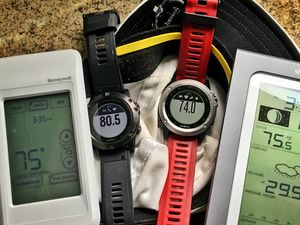
If you're interested in temperature, I'd recommend getting a Garmin Tempe as an external temperature sensor as it's a lot more accurate. I attach mine to the underside of my hat.
 The Garmin Tempe temperature sensor, attached to my Running Hat for the best reading. |
13.4 Muscle Oxygen Sensor
Native support for Moxy is nice to see. Previously you had to either use a Connect IQ data field or configure Moxy to be a Footpod and have the Muscle Oxygen Saturation in the Cadence field.
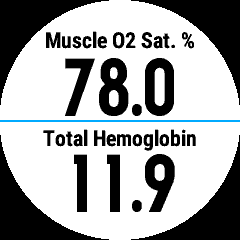 Here you can see the real time display of both Muscle Oxygen Saturation (which is quite different to SpO2 and total Hb. |
Here's my Moxy incorrectly placed; I'd put the Moxy on my right leg with my Fenix 5X on my left wrist, which puts them too far apart and I didn't get a reading.
14 GPS Accuracy
I've tested the GPS Accuracy of the Fenix 5X with the latest GPS firmware, and it's possible that its accuracy will improve as the firmware matures. Based on my testing, the Fenix 5X certainly has plenty of room for improvement. At best, the GPS accuracy could be described as mediocre, and I think it's bad enough that it could significantly mess up your training. If you look at the middle, curved section, you can see that the Fenix 5X is doing particularly badly here. This is a challenging section, and reveals any weakness in a GPS watch. The right most segment with the right-angle turn is a section of the most watches do reasonably well on, but the Fenix 5X is struggling here as well. The tracks don't look too bad, you can see that the Fenix 5X is not able to calculate the distance correctly. The Fenix 5X doesn't get too badly confused going under the bridge, actually looks a little better in that area than the two Suunto watches shown for comparison. The blue lap markers are rather widely spread, again giving more evidence of poor GPS accuracy. It's possible that other versions of the Fenix 5 might have different GPS accuracy. It's possible that the plastic 935 might do a little better, but without testing it's impossible to know. (I buy all my test gear through retail channels. This allows me to be brutally honest in my reviews, as I don't need to keep the manufacturer happy in order to continue getting free samples or early access. The downside is that I'm more limited in the array of watches I can test. Therefore, it's unlikely that I will test other versions of the Fenix 5 at this point.) I've tested both the 4.20 and the 4.30 version of the GPS firmware (see below for details.)
 For comparison, here are the tracks from the Suunto Spartan Ultra, which had appalling GPS accuracy when it was first released, but the latest firmware has improved things. |
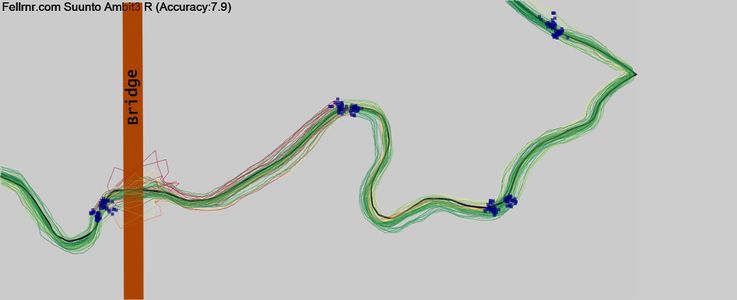 Here's how the Suunto Ambit3's accuracy looks. |
As with all the watches I test, I first left the Fenix 5X in its "ready to go" mode with a clear view of the sky for over 30 minutes. This is to ensure that the chipset has ample time to download the almanac from the satellites, which should only take about 12 minutes. I also give the Fenix 5X at least five minutes after it has got a satellite lock before starting my run. This is to give it the best possible chance of having good accuracy. (Like most modern GPS watches, the Fenix 5X will download information on the satellite orbits when it's synced, but this predicted information is not as good as the live for data transmitted by the satellites themselves.)
Remember that to the overall firmware version number doesn't influence GPS accuracy. You have to look at the GPS firmware number.
14.1 Smart or One Second Recording?
The tests are with GLONAS off as I've consistently found in prior testing that GLONAS reduces accuracy. I also use smart recording rather than 1-second as this only changes recording frequency, not the frequency of GPS polling. Below is a comparison of 1-second and smart recording to demonstrate this.
| Device | Accuracy | Trueness | Precision | Repeatability |
|---|---|---|---|---|
| Fenix 5X 4.30 Smart Recording | 5.6 | 6.9 | 4.5 | 6.8 |
| Fenix 5X 4.30 One Second Recording | 5.3 | 7.1 | 4.0 | 6.6 |
14.2 UltraTrac Recording Accuracy
Like a number of other Garmin watches, the Fenix 5X supports Garmin's UltraTrac mode. This mode turns the GPS off periodically, and in theory it uses the internal accelerometer to estimate the distance. Garmin indicates that the accuracy should improve with use, but I've covered hundreds of miles since the last factory reset, so I think it's as good as it's likely to get. Unlike other watches that specify a regular polling interval, such as every 15 seconds, UltraTrac does not specify the interval. I have recording set to every second, and the Fenix 5X records location information that's updated each second, though it's obvious from the track shape that it's interpolating from periodic polling. I think that the accuracy seems to drop after a few hours, but I can't be sure as I don't have enough data to do a statistical analysis. As you can see from the table below, the GPS Accuracy with UltraTrac is predictably grim. This is not unreasonable, given this is clearly trading off accuracy for battery life. (I've used percentage errors rather than the scores I've used above as the level of error in UltraTrac messes up my score calculations.)
| Device | Accuracy (Combined) |
Trueness (Average Distance Error) |
Standard Deviation (From mean) |
Standard Deviation (From true) |
Repeatability |
|---|---|---|---|---|---|
| Fenix 5X 4.30 Normal GPS | 4.44% (234.5 Ft/Mile, 44.4 m/Km) | 3.12% (164.6 Ft/Mile, 31.2 m/Km) | 4.33% (228.7 Ft/Mile, 43.3 m/Km) | 5.45% (287.9 Ft/Mile, 54.5 m/Km) | 3.24% (171.1 Ft/Mile, 32.4 m/Km) |
| Fenix 5X 4.30 UltraTrac | 15.92% (840.7 Ft/Mile, 159.2 m/Km) | 14.62% (772.1 Ft/Mile, 146.2 m/Km) | 6.40% (337.8 Ft/Mile, 64.0 m/Km) | 17.12% (904.2 Ft/Mile, 171.2 m/Km) | 5.93% (313.0 Ft/Mile, 59.3 m/Km) |
As you'd expect, the GPS tracks show the typical straight lines you get from periodic GPS polling. You'll notice however that the GPS is turned on long enough to get several readings as there are various wiggles and loops at the corners of the track lines.
14.3 GLONASS Accuracy
With GLONASS enabled, the Fenix 5X demonstrates even worse performance than its peers. The values shown below are rather dramatically worse with GLONASS enabled than without. My anecdotal observation is that sometimes the Fenix 5X does a little worse with GLONASS than normal, possibly in line with other Garmin devices, and sometimes it seems to just get lost and produce dramatically worse results.
| Device | Accuracy | Trueness | Precision | Repeatability |
|---|---|---|---|---|
| Fenix 5X 4.30 | 5.6 | 6.9 | 4.5 | 6.8 |
| Fenix 5X 4.30 GLONASS | 3.5 | 6.2 | 1.6 | 3.5 |
Below you can see a visual representation of the problems. Many of the tracks are a little worse than normal, but you generally follow the path. A small subset of the tracks are dramatically worse, either showing and offset from the actual path, or sometimes it looks like the sampling frequency has dropped, suggesting that the watch is only periodically able to get a location fix. This latter phenomenon is rather surprising to me and goes against my hypothesis of why GLONASS has worse accuracy. I would expect there would be more satellites available with GLONASS enabled, which would result in the watch selecting the subset with the strongest signal that are more likely to have a narrow angle of separation, which would result in increased Dilution of Precision (DoP). These tracks suggest that the Fenix 5X is unable to get any location fix for brief periods.
15 Optical Heart Rate Monitoring
I've not found any Optical Heart Rate Monitoring (OHRM) implementation that's good enough to be useful, and the Fenix 5X is no exception. I believe that you're better off having no heart rate data than bad heart rate data. While a chest strap based heart rate monitor can have accuracy issues, these are generally dramatic and obvious, whereas OHRM can be quite misleading. (The issues with a chest strap heart rate monitor are also usually fairly easy to remediate, either with some electrode gel or a new battery.) The accuracy of Optical Heart Rate Monitoring (OHRM) will depend on a number of factors:
- The watch needs to fit just right. Because of the sensor is measuring the expansion of the capillaries with each heartbeat, too much pressure will prevent this expansion. However, to lose and the watch won't get a good reading due to lack of contact. Getting this tension just right can be tricky, especially if you're wrist expands or contracts over time.
- Movement seems to confuse OHRM systems, possibly because it changes the papillary filling. Some users have noted that their OHRM systems seem to lock on to their Cadence rather than their heart rate.
- Temperature seems to be a huge factor, and most systems work better in warmer conditions. If you're a little chilled, your body will restrict blood flow to your capillaries to retain body heat, making it much harder for the optical HRM. Of course, because the system needs to be against the skin, it can be tricky to use them in cold conditions. I've cut a hole in a arm warmer so that I can see the watch face while preventing frostbite to the surrounding skin.
- It's possible that bright sunlight might also influence the accuracy, though I've not noticed any obvious correlation.
While it's possible to compare the graph of heart rate data from the Fenix 5X with a chest strap, such an approach doesn't provide very much data. Instead, I've gathered over 10,000 data points and an analyzed them. The two graphs below are taken during my runs with the Fenix 5X. The graph on the left plots the heart rate from the optical HRM of the Fenix 5X against a chest strap based reading. All of the points should lie along the pale green line, which represents the optical HRM reading the same as the chest strap. The two red lines represent an error of 25 bpm, and the blue line represents the regression line. The graph on the right is a distribution map of the errors. As you can see, the Fenix 5X optical HRM is a fairly close for a good portion of the time, but overall there are a lot of bad readings.
I thought that perhaps the Fenix 5X would do better when I'm not running. After all, it's able to read my heart rate continuously, so even if the optical HRM is useless for running, I wondered if it might be valuable for evaluating my activity the rest of the day. I was rather surprised, and more than a little disappointed, to learn that the Fenix 5X seems to do even worse when I'm sedentary than it does when I'm running.
I had rather limited hope that the Fenix 5X would be of any use overnight, but it actually did surprisingly well. I suspect that the darkness and the lack of movement made things a little easier for it. It's also possible that a much lower heart rate is easier to lock on.
The Fenix 5X uses three green LEDs surrounding the light sensor, and there's no light shield as there was on the Garmin 225, an approach that seems to have been abandoned.
Using an optical HRM in cold weather is awkward. You need to have the watch in contact with your skin, so you can't wear it over the top of your and clothing. On the other hand, if you wear it under your warm clothing you can't see the display. My solution is to use an arm warmer with a hole cut out so that I can see the display. This works fairly well, and has the added advantage of blocking some of the light that can interfere with the optical sensor.
16 Adding Stryd
Adding a Stryd footpod is fairly easy, but make sure you disable auto calibration. For more details, here's a short walkthrough.
17 Comparison Table
I evaluate running watches in three distinct ways. Firstly, you can use a watch on its own, without any kind of Footpod. This is probably the most common way runners use their watch, but you miss out on a lot. The second rating is with a standard Footpod that is available quite cheaply. These Footpod's can be reasonably accurate once the calibrated, but calibration is a little tedious. The final evaluation is with the Stryd Footpod, which is vastly more accurate than any other type of Footpod, or and more accurate than GPS. The table below looks at the score, and the value for money of each watch for each of the three conditions. (I’ve also tested the Apple Watch 3, but I’ve not included it in these tables as it’s not really a running watch.)
| Review | With Stryd Score | With Stryd Value for money | With Footpod Score | With Footpod Value for money | Without Footpod Score | Without Footpod Value for money | Price at Amazon.com |
|---|---|---|---|---|---|---|---|
| Garmin Epix Review | 47 | 4.5 | 31 | 3.9 | 23 | 3.4 | Error: Could not parse data from Amazon! |
| Garmin Fenix 5X Review | 47 | 2.9 | 32 | 2.3 | 24 | 1.9 | Error: Could not parse data from Amazon! |
| Garmin Fenix 3 Review | 45 | 3.8 | 28 | 3.1 | 24 | 3 | Error: Could not parse data from Amazon! |
| Garmin 935 Review | 45 | 3.6 | 30 | 3 | 22 | 2.4 | Error: Could not parse data from Amazon! |
| Garmin Vivoactive HR Review | 40 | 4.9 | 21 | 3.8 | 17 | 3.8 | Error: Could not parse data from Amazon! |
| Garmin 920XT Review | 39 | 4.4 | 30 | 4.7 | 24 | 4.5 | Error: Could not parse data from Amazon! |
| Suunto Spartan Ultra Review | 37 | 2.6 | 27 | 2.3 | 23 | 2.1 | Error: Could not parse data from Amazon! |
| Garmin Vivoactive 3 Review | 36 | 4 | 19 | 2.9 | 15 | 2.8 | Error: Could not parse data from Amazon! |
| Garmin Vivoactive Review | 34 | 5.1 | 14 | 3.4 | 10 | 3.3 | Error: Could not parse data from Amazon! |
| Suunto Spartan Trainer Review | 34 | 3.9 | 23 | 3.7 | 18 | 3.4 | Error: Could not parse data from Amazon! |
| Polar V800 Review | 33 | 2.8 | 26 | 2.8 | 22 | 2.7 | Error: Could not parse data from Amazon! |
| Suunto Ambit2 Review | 32 | 3.9 | 25 | 4.3 | 21 | 4.5 | Error: Could not parse data from Amazon! |
| Suunto Ambit3 Peak Review | 32 | 3.4 | 29 | 4.1 | 25 | 4.2 | Error: Could not parse data from Amazon! |
| Garmin Fenix 2 Review | 31 | 2.9 | 22 | 2.7 | 18 | 2.5 | Error: Could not parse data from Amazon! |
| Suunto Ambit3 Run Review | 30 | 4 | 27 | 5.5 | 23 | 5.9 | Error: Could not parse data from Amazon! |
| Suunto Ambit2 R Review | 30 | 3.5 | 23 | 3.8 | 19 | 3.8 | Error: Could not parse data from Amazon! |
| Garmin 235 Review | 28 | 2.9 | 20 | 2.8 | 12 | 2 | Error: Could not parse data from Amazon! |
| Garmin 620 Review | 27 | 3.8 | 24 | 5.1 | 20 | 5.6 | Error: Could not parse data from Amazon! |
| Garmin 910XT Review | 26 | 3.9 | 26 | 6.1 | 21 | 6.7 | Error: Could not parse data from Amazon! |
| Garmin 310XT Review | 25 | 4.6 | 24 | 8.3 | 18 | 10 | Error: Could not parse data from Amazon! |
| Polar M400 Review | 25 | 4.3 | 15 | 4.5 | 11 | 4.9 | Error: Could not parse data from Amazon! |
| Garmin 225 Review | 25 | 3.8 | 13 | 3.1 | 9 | 2.9 | Error: Could not parse data from Amazon! |
| TomTom Cardio Runner Review | 25 | 3.3 | 10 | 2 | 10 | 2.5 | Error: Could not parse data from Amazon! |
| Polar M430 Review | 25 | 3.2 | 15 | 2.9 | 11 | 2.7 | Error: Could not parse data from Amazon! |
| Garmin 610 Review | 24 | 3.3 | 20 | 4.3 | 14 | 3.9 | Error: Could not parse data from Amazon! |
| Leikr Review | 10 | 1 | 20 | 2.5 | 14 | 2 | Leikr ($380) |
| Epson SF-510 Review | 4 | 0.7 | 6 | 2 | 6 | 3 | Error: Could not parse data from Amazon! |
| Epson SF-810 Review | 4 | 0.6 | 6 | 1.6 | 6 | 2.3 | Error: Could not parse data from Amazon! |
| Garmin 10 Review | 2 | 0.3 | 2 | 0.6 | 2 | 0.9 | Error: Could not parse data from Amazon! |
The score is the sum of how well each watch can answer the four basic questions (how far, how fast, where are you, what's your cadence), plus some bonus points.
- The "How far you've run" will be based on GPS only for "without Footpod" and "with Standard Footpod", but based on Stryd if supported in the "with Stryd Footpod" table..
- How fast you're running assumes you're using a Footpod if it's supported, otherwise the rating is 0-2 based on GPS accuracy.
- The "Where are you?" is based on various navigation features such as back to start, breadcrumbs, and preloaded maps. For some watches, you have to turn GPS off to get the benefit of Stryd, so those watches have worse "where are you scores" with Stryd than without.
- The cadence score uses 1 point for an internal cadence sensor, 2 points for footpod support, 1 point for support from chest strap cadence, and 1 point for cadence alerts.
- I give 1-2 bonus points for application support, 1-2 bonus points for data upload, 1-2 bonus points for Optical Heart Rate Monitoring, and 0-1 bonus points for battery life.
- Value for money is the score divided by the price (at the time I last updated the table.) Your needs may be different, so you might weight the different aspects of the watches differently, or be basing your decision on different criteria totally. Hopefully this table will give you a good starting point for your decision.
17.1 Score Breakdown without a Footpod
| Review | Score | Value for money6 | How far did you run?1 |
How fast are you running?2 |
Where are you?3 |
What's your cadence?4 |
Bonus Points5 | class="unsortable" |
Price at Amazon.com |
|---|---|---|---|---|---|---|---|---|
| Suunto Ambit3 Peak Review | 25 | 4.2 | 8 | 3 | 6 | 2 | 6 | Error: Could not parse data from Amazon! |
| Garmin 920XT Review | 24 | 4.5 | 1 | 2 | 7 | 6 | 8 | Error: Could not parse data from Amazon! |
| Garmin Fenix 3 Review | 24 | 3 | 2 | 1 | 7 | 6 | 8 | Error: Could not parse data from Amazon! |
| Garmin Fenix 5X Review | 24 | 1.9 | 1 | 0 | 9 | 6 | 8 | Error: Could not parse data from Amazon! |
| Suunto Ambit3 Run Review | 23 | 5.9 | 8 | 3 | 5 | 2 | 5 | Error: Could not parse data from Amazon! |
| Garmin Epix Review | 23 | 3.4 | 0 | 0 | 9 | 6 | 8 | Error: Could not parse data from Amazon! |
| Suunto Spartan Ultra Review | 23 | 2.1 | 8 | 2 | 6 | 2 | 5 | Error: Could not parse data from Amazon! |
| Polar V800 Review | 22 | 2.7 | 9 | 4 | 3 | 2 | 4 | Error: Could not parse data from Amazon! |
| Garmin 935 Review | 22 | 2.4 | 1 | 0 | 7 | 6 | 8 | Error: Could not parse data from Amazon! |
| Garmin 910XT Review | 21 | 6.7 | 5 | 3 | 6 | 2 | 5 | Error: Could not parse data from Amazon! |
| Suunto Ambit2 Review | 21 | 4.5 | 4 | 3 | 6 | 2 | 6 | Error: Could not parse data from Amazon! |
| Garmin 620 Review | 20 | 5.6 | 3 | 2 | 2 | 6 | 7 | Error: Could not parse data from Amazon! |
| Suunto Ambit2 R Review | 19 | 3.8 | 4 | 3 | 5 | 2 | 5 | Error: Could not parse data from Amazon! |
| Garmin 310XT Review | 18 | 10 | 7 | 2 | 4 | 0 | 5 | Error: Could not parse data from Amazon! |
| Suunto Spartan Trainer Review | 18 | 3.4 | 5 | 3 | 4 | 2 | 4 | Error: Could not parse data from Amazon! |
| Garmin Fenix 2 Review | 18 | 2.5 | 1 | 0 | 6 | 6 | 5 | Error: Could not parse data from Amazon! |
| Garmin Vivoactive HR Review | 17 | 3.8 | 0 | 0 | 2 | 6 | 9 | Error: Could not parse data from Amazon! |
| Garmin Vivoactive 3 Review | 15 | 2.8 | 0 | 0 | 4 | 4 | 7 | Error: Could not parse data from Amazon! |
| Garmin 610 Review | 14 | 3.9 | 3 | 2 | 3 | 2 | 4 | Error: Could not parse data from Amazon! |
| Leikr Review | 14 | 2 | 5 | 2 | 4 | 0 | 3 | Leikr ($380) |
| Garmin 235 Review | 12 | 2 | 0 | 0 | 2 | 2 | 8 | Error: Could not parse data from Amazon! |
| Polar M400 Review | 11 | 4.9 | 3 | 1 | 1 | 2 | 4 | Error: Could not parse data from Amazon! |
| Polar M430 Review | 11 | 2.7 | 3 | 1 | 1 | 2 | 4 | Error: Could not parse data from Amazon! |
| Garmin Vivoactive Review | 10 | 3.3 | 0 | 0 | 0 | 6 | 4 | Error: Could not parse data from Amazon! |
| TomTom Cardio Runner Review | 10 | 2.5 | 2 | 1 | 0 | 2 | 5 | Error: Could not parse data from Amazon! |
| Garmin 225 Review | 9 | 2.9 | 1 | 1 | 0 | 2 | 5 | Error: Could not parse data from Amazon! |
| Epson SF-510 Review | 6 | 3 | 0 | 0 | 0 | 2 | 4 | Error: Could not parse data from Amazon! |
| Epson SF-810 Review | 6 | 2.3 | 1 | 0 | 0 | 2 | 3 | Error: Could not parse data from Amazon! |
| Garmin 10 Review | 2 | 0.9 | 0 | 0 | 0 | 0 | 2 | Error: Could not parse data from Amazon! |
17.2 Score Breakdown with a Standard Footpod
| Review | Score | Value for money6 | How far did you run?1 |
How fast are you running?2 |
Where are you?3 |
What's your cadence?4 |
Bonus Points5 | class="unsortable" |
Price at Amazon.com |
|---|---|---|---|---|---|---|---|---|
| Garmin Fenix 5X Review | 32 | 2.3 | 1 | 4 | 9 | 10 | 8 | Error: Could not parse data from Amazon! |
| Garmin Epix Review | 31 | 3.9 | 0 | 4 | 9 | 10 | 8 | Error: Could not parse data from Amazon! |
| Garmin 920XT Review | 30 | 4.7 | 1 | 4 | 7 | 10 | 8 | Error: Could not parse data from Amazon! |
| Garmin 935 Review | 30 | 3 | 1 | 4 | 7 | 10 | 8 | Error: Could not parse data from Amazon! |
| Suunto Ambit3 Peak Review | 29 | 4.1 | 8 | 3 | 6 | 6 | 6 | Error: Could not parse data from Amazon! |
| Garmin Fenix 3 Review | 28 | 3.1 | 2 | 1 | 7 | 10 | 8 | Error: Could not parse data from Amazon! |
| Suunto Ambit3 Run Review | 27 | 5.5 | 8 | 3 | 5 | 6 | 5 | Error: Could not parse data from Amazon! |
| Suunto Spartan Ultra Review | 27 | 2.3 | 8 | 2 | 6 | 6 | 5 | Error: Could not parse data from Amazon! |
| Garmin 910XT Review | 26 | 6.1 | 5 | 4 | 6 | 6 | 5 | Error: Could not parse data from Amazon! |
| Polar V800 Review | 26 | 2.8 | 9 | 4 | 3 | 6 | 4 | Error: Could not parse data from Amazon! |
| Suunto Ambit2 Review | 25 | 4.3 | 4 | 3 | 6 | 6 | 6 | Error: Could not parse data from Amazon! |
| Garmin 310XT Review | 24 | 8.3 | 7 | 4 | 4 | 4 | 5 | Error: Could not parse data from Amazon! |
| Garmin 620 Review | 24 | 5.1 | 3 | 2 | 2 | 10 | 7 | Error: Could not parse data from Amazon! |
| Suunto Ambit2 R Review | 23 | 3.8 | 4 | 3 | 5 | 6 | 5 | Error: Could not parse data from Amazon! |
| Suunto Spartan Trainer Review | 23 | 3.7 | 5 | 4 | 4 | 6 | 4 | Error: Could not parse data from Amazon! |
| Garmin Fenix 2 Review | 22 | 2.7 | 1 | 0 | 6 | 10 | 5 | Error: Could not parse data from Amazon! |
| Garmin Vivoactive HR Review | 21 | 3.8 | 0 | 0 | 2 | 10 | 9 | Error: Could not parse data from Amazon! |
| Garmin 610 Review | 20 | 4.3 | 3 | 4 | 3 | 6 | 4 | Error: Could not parse data from Amazon! |
| Garmin 235 Review | 20 | 2.8 | 0 | 4 | 2 | 6 | 8 | Error: Could not parse data from Amazon! |
| Leikr Review | 20 | 2.5 | 5 | 4 | 4 | 4 | 3 | Leikr ($380) |
| Garmin Vivoactive 3 Review | 19 | 2.9 | 0 | 0 | 4 | 8 | 7 | Error: Could not parse data from Amazon! |
| Polar M400 Review | 15 | 4.5 | 3 | 1 | 1 | 6 | 4 | Error: Could not parse data from Amazon! |
| Polar M430 Review | 15 | 2.9 | 3 | 1 | 1 | 6 | 4 | Error: Could not parse data from Amazon! |
| Garmin Vivoactive Review | 14 | 3.4 | 0 | 0 | 0 | 10 | 4 | Error: Could not parse data from Amazon! |
| Garmin 225 Review | 13 | 3.1 | 1 | 1 | 0 | 6 | 5 | Error: Could not parse data from Amazon! |
| TomTom Cardio Runner Review | 10 | 2 | 2 | 1 | 0 | 2 | 5 | Error: Could not parse data from Amazon! |
| Epson SF-510 Review | 6 | 2 | 0 | 0 | 0 | 2 | 4 | Error: Could not parse data from Amazon! |
| Epson SF-810 Review | 6 | 1.6 | 1 | 0 | 0 | 2 | 3 | Error: Could not parse data from Amazon! |
| Garmin 10 Review | 2 | 0.6 | 0 | 0 | 0 | 0 | 2 | Error: Could not parse data from Amazon! |
17.3 Score Breakdown with a Stryd Footpod
| Review | Score | Value for money6 | How far did you run?1 |
How fast are you running?2 |
Where are you?3 |
What's your cadence?4 |
Bonus Points5 | class="unsortable" |
Price at Amazon.com |
|---|---|---|---|---|---|---|---|---|
| Garmin Epix Review | 47 | 4.5 | 10 | 10 | 9 | 10 | 8 | Error: Could not parse data from Amazon! |
| Garmin Fenix 5X Review | 47 | 2.9 | 10 | 10 | 9 | 10 | 8 | Error: Could not parse data from Amazon! |
| Garmin Fenix 3 Review | 45 | 3.8 | 10 | 10 | 7 | 10 | 8 | Error: Could not parse data from Amazon! |
| Garmin 935 Review | 45 | 3.6 | 10 | 10 | 7 | 10 | 8 | Error: Could not parse data from Amazon! |
| Garmin Vivoactive HR Review | 40 | 4.9 | 10 | 10 | 1 | 10 | 9 | Error: Could not parse data from Amazon! |
| Garmin 920XT Review | 39 | 4.4 | 10 | 10 | 1 | 10 | 8 | Error: Could not parse data from Amazon! |
| Suunto Spartan Ultra Review | 37 | 2.6 | 10 | 10 | 6 | 6 | 5 | Error: Could not parse data from Amazon! |
| Garmin Vivoactive 3 Review | 36 | 4 | 10 | 10 | 1 | 8 | 7 | Error: Could not parse data from Amazon! |
| Garmin Vivoactive Review | 34 | 5.1 | 10 | 10 | 0 | 10 | 4 | Error: Could not parse data from Amazon! |
| Suunto Spartan Trainer Review | 34 | 3.9 | 10 | 10 | 4 | 6 | 4 | Error: Could not parse data from Amazon! |
| Polar V800 Review | 33 | 2.8 | 10 | 10 | 3 | 6 | 4 | Error: Could not parse data from Amazon! |
| Suunto Ambit2 Review | 32 | 3.9 | 10 | 10 | 6 | 0 | 6 | Error: Could not parse data from Amazon! |
| Suunto Ambit3 Peak Review | 32 | 3.4 | 10 | 10 | 6 | 0 | 6 | Error: Could not parse data from Amazon! |
| Garmin Fenix 2 Review | 31 | 2.9 | 10 | 10 | 6 | 0 | 5 | Error: Could not parse data from Amazon! |
| Suunto Ambit3 Run Review | 30 | 4 | 10 | 10 | 5 | 0 | 5 | Error: Could not parse data from Amazon! |
| Suunto Ambit2 R Review | 30 | 3.5 | 10 | 10 | 5 | 0 | 5 | Error: Could not parse data from Amazon! |
| Garmin 235 Review | 28 | 2.9 | 10 | 10 | 0 | 0 | 8 | Error: Could not parse data from Amazon! |
| Garmin 620 Review | 27 | 3.8 | 10 | 10 | 0 | 0 | 7 | Error: Could not parse data from Amazon! |
| Garmin 910XT Review | 26 | 3.9 | 10 | 10 | 1 | 0 | 5 | Error: Could not parse data from Amazon! |
| Garmin 310XT Review | 25 | 4.6 | 10 | 10 | 0 | 0 | 5 | Error: Could not parse data from Amazon! |
| Polar M400 Review | 25 | 4.3 | 10 | 10 | 1 | 0 | 4 | Error: Could not parse data from Amazon! |
| Garmin 225 Review | 25 | 3.8 | 10 | 10 | 0 | 0 | 5 | Error: Could not parse data from Amazon! |
| TomTom Cardio Runner Review | 25 | 3.3 | 10 | 10 | 0 | 0 | 5 | Error: Could not parse data from Amazon! |
| Polar M430 Review | 25 | 3.2 | 10 | 10 | 1 | 0 | 4 | Error: Could not parse data from Amazon! |
| Garmin 610 Review | 24 | 3.3 | 10 | 10 | 0 | 0 | 4 | Error: Could not parse data from Amazon! |
| Leikr Review | 10 | 1 | 5 | 2 | 0 | 0 | 3 | Leikr ($380) |
| Epson SF-510 Review | 4 | 0.7 | 0 | 0 | 0 | 0 | 4 | Error: Could not parse data from Amazon! |
| Epson SF-810 Review | 4 | 0.6 | 1 | 0 | 0 | 0 | 3 | Error: Could not parse data from Amazon! |
| Garmin 10 Review | 2 | 0.3 | 0 | 0 | 0 | 0 | 2 | Error: Could not parse data from Amazon! |
17.4 Basic Features
|
Review |
Released | GPS Accuracy |
Weight (oz) | Size (CM3) | Display (mm) | Resolution (Pixels) | Waterproofing | Heart Rate Monitor |
Cadence | Data Upload |
|---|---|---|---|---|---|---|---|---|---|---|
| Garmin Epix Review | 2015 | 6.2 | 3.0 | 48 | 29 x 21 (609mm2) | 205 x 148 (30.3K total) | Good (50m) | Yes | Internal/Footpod/Heart Rate Monitor/Alert | Yes |
| Garmin Fenix 5X Review | 2017 | 5.6 | 3.5 | 36 | 30.5 (round) (731mm2) | 240 diameter (45.2K total) | Good (100m) | Yes | Internal/Footpod/Heart Rate Monitor/Alert | Yes |
| Garmin Fenix 3 Review | 2015 | 6.2 | 2.9 | 33 | 30 (round) (726mm2) | 218 diameter (37.3K total) | Good (100m) | Yes | Internal/Footpod/Heart Rate Monitor/Alert | Yes |
| Garmin 935 Review | 2017 | 5.6 | 1.7 | 24 | 30.5 (round) (731mm2) | 240 diameter (45.2K total) | Good (100m) | Yes | Internal/Footpod/Heart Rate Monitor/Alert | Yes |
| Garmin Vivoactive HR Review | 2016 | 4.9 | 1.7 | 19 | 21 x 29 (609mm2) | 148 x 205 (30.3K total) | Good (50m) | Yes (+OHRM) | Internal/Footpod/Heart Rate Monitor/Alert | Yes |
| Garmin 920XT Review | 2014 | 6.6 | 2.2 | 35 | 29 x 21 (609mm2) | 205 x 148 (30.3K total) | Good (50m) | Yes | Internal/Footpod/Heart Rate Monitor/Alert | Yes |
| Garmin Vivoactive 3 Review | 2017 | 1.5 | 17 | 30.5 (round) (731mm2) | 240 diameter (45.2K total) | Good (50m) | Yes (+OHRM) | Internal/Footpod | Yes | |
| Garmin Vivoactive Review | 2015 | 5.4 | 1.3 | 13 | 29 x 21 (592mm2) | 205 x 148 (30.3K total) | Good (50m) | Yes | Internal/Footpod/Heart Rate Monitor/Alert | Yes |
| Suunto Spartan Trainer Review | 2017 | 7.8 | 2.0 | 25 | 24 x 23 (529mm2) | 128 diameter (12.9K total) | Good (50m) | Yes (+OHRM) | Internal/Footpod | Yes |
| Suunto Ambit2 Review | 2013 | 7.6 | 3.1 | 30 | 29 (round) (661mm2) | 128 diameter (12.9K total) | Good (100m) | Yes | Internal/Footpod | Yes |
| Suunto Ambit3 Peak Review | 2014 | 7.9 | 2.9 | 30 | 29 (round) (661mm2) | 128 diameter (12.9K total) | Good (100m) | Yes | Internal/Footpod | Yes |
| Suunto Spartan Ultra Review | 2016 | 7.1 | 2.7 | 38 | 32 (round) (804mm2) | 320 diameter (80.4K total) | Good (100m) | Yes | Internal (Limited Footpod) | Yes |
| Garmin Fenix 2 Review | 2014 | 5.7 | 3.2 | 32 | 31 (round) (755mm2) | 70 diameter (3.8K total) | Good (50m) | Yes | Internal/Footpod/Heart Rate Monitor/Alert | Yes |
| Suunto Ambit3 Run Review | 2014 | 7.9 | 2.5 | 30 | 29 (round) (661mm2) | 128 x 128 (16.4K total) | Good (50m) | Yes | Internal/Footpod | Yes |
| Suunto Ambit2 R Review | 2013 | 7.6 | 2.5 | 30 | 29 (round) (661mm2) | 128 diameter (12.9K total) | Good (50m) | Yes | Internal/Footpod | Yes |
| Garmin 235 Review | 2015 | 4.9 | 1.5 | 19 | 31 (round) (755mm2) | 215 diameter (36.3K total) | Good (50m) | Yes (+OHRM) | Internal/Footpod | Yes |
| Garmin 620 Review | 2013 | 7.1 | 1.5 | 20 | 25.4 (round) (507mm2) | 180 diameter (25.4K total) | Good (50m) | Yes | Internal/Footpod/Heart Rate Monitor/Alert | Yes |
| Garmin 910XT Review | 2011 | 7.5 | 2.5 | 49 | 33 x 20 (660mm2) | 160 x 100 (16K total) | Good (50m) | Yes | Footpod/Alert | Yes |
| Garmin 310XT Review | 2009 | 7.5 | 2.5 | 63 | 33 x 20 (660mm2) | 160 x 100 (16K total) | Good (50m) | Yes | Footpod | Yes |
| Garmin 225 Review | 2015 | 6.2 | 1.5 | 24 | 25.4 (round) (507mm2) | 180 diameter (25.4K total) | Good (50m) | Yes (+OHRM) | Internal/Footpod | Yes |
| TomTom Cardio Runner Review | 2015 | 6.0 | 2.2 | 30 | 22 x 25 (550mm2) | 144 x 168 (24.2K total) | Good (50m) | Yes (+OHRM) | Internal/Footpod | Yes |
| Polar V800 Review | 2014 | 8.0 | 2.8 | 31 | 23 x 23 (529mm2) | 128 x 128 (16.4K total) | Good (30m) | Yes | Internal/Footpod | Yes |
| Polar M430 Review | 2017 | 7.2 | 2.0 | 24 | 23 x 23 (529mm2) | 128 x 128 (16.4K total) | Good (50m) | Yes (+OHRM) | Internal/Footpod | Yes |
| Polar M400 Review | 2014 | 6.6 | 2.0 | 24 | 23 x 23 (529mm2) | 128 x 128 (16.4K total) | Good (30m) | Yes | Internal/Footpod | Yes |
| Garmin 610 Review | 2011 | 7.3 | 2.5 | 41 | 25.4 (round) (507mm2) | 128 diameter (12.9K total) | Fair (IPX7) | Yes | Footpod/Alert | Yes |
| Leikr Review | 2013 | 7.3 | 2.4 | 25 | 41 x 31 (1271mm2) | 206 x 148 (76.8K total) | Fair (IPX6) | Yes | Footpod | Limited |
| Epson SF-510 Review | 2015 | 4.4 | 1.7 | 24 | 28 x 22 (616mm2) | 128 x 96 (12.3K total) | Good (50m) | Yes | Limited Internal | Limited |
| Epson SF-810 Review | 2015 | 5.5 | 1.8 | 28 | 28 (round) (616mm2) | 128 diameter (12.9K total) | Good (50m) | OHRM Only) | Limited Internal | Limited |
| Garmin 10 Review | 2012 | 3.8 | 1.3 | 33 | 25 x 24 (600mm2) | 55 x 32 (1.8K total) | Good (50m) | No | No | Yes |
|
Review |
Battery Life (hr) |
Tested Battery Life (hr) |
Extended Battery Life (hr) |
Charge On The Run? | Training Effect |
HRV | GPS cache | Sensors |
|---|---|---|---|---|---|---|---|---|
| Garmin Epix Review | 24 | 17.6 | 50 | Yes (with USB=Garmin) | Yes | Record | Yes | Ant+ |
| Garmin Fenix 5X Review | 20 | 23 | 35 | Yes, but can't be worn | Yes | Record | Yes | Bluetooth/Ant+ |
| Garmin Fenix 3 Review | 20 | 22 | 50 | Yes (with USB=Garmin) | Yes | No | Yes | Ant+ |
| Garmin 935 Review | 24 | 24.5 | 60 | Yes, but can't be worn | Yes | Record | Yes | Bluetooth/Ant+ |
| Garmin Vivoactive HR Review | 13 | 13 | Yes (with USB=Garmin) | No | No | Yes | Ant+ | |
| Garmin 920XT Review | 24 | 19 | 40 | No (terminates) | Yes | Record | Yes | Ant+ |
| Garmin Vivoactive 3 Review | 13 | 13 | No | Yes | Bluetooth/Ant+ | |||
| Garmin Vivoactive Review | 10 | 10 | 10 | Yes (with USB=Garmin) | No | No | Yes | Ant+ |
| Suunto Spartan Trainer Review | 10 | 11 | 30 | Yes | Yes | No | Yes | Bluetooth |
| Suunto Ambit2 Review | 15 | 50 | Yes | Yes | Record | Yes | Ant+ | |
| Suunto Ambit3 Peak Review | 20 | 100 | Yes | Yes | Record | Yes | Bluetooth | |
| Suunto Spartan Ultra Review | 18 | 17 | 26 | Yes, but can't be worn | Yes | Record | Yes | Bluetooth |
| Garmin Fenix 2 Review | 15 | 50 | Yes (with USB=Garmin) | Yes | No | Yes | Ant+ | |
| Suunto Ambit3 Run Review | 10 | 10.5 | 100 | Yes | Yes | Record | Yes | Bluetooth |
| Suunto Ambit2 R Review | 8 | 7.3 | 25 | Yes | Yes | Record | Yes | Ant+ |
| Garmin 235 Review | 11 | 11 | Yes, but no optical HR | Yes | No | Yes | Ant+ | |
| Garmin 620 Review | 10 | 10 | No (resets) | Yes | Record | Yes | Ant+ | |
| Garmin 910XT Review | 20 | 20 | Yes, but no display | Yes | Record | No | Ant+ | |
| Garmin 310XT Review | 20 | 20 | Yes, but no display | No | No | No | Ant+ | |
| Garmin 225 Review | 10 | 11 | 10 | No (resets) | No | No | Yes | Ant+ |
| TomTom Cardio Runner Review | 8 | 6.3 | 8 | No (resets) | No | No | Yes | Bluetooth HR |
| Polar V800 Review | 13 | 24 | 50 | No (terminates) | Yes | Display | Predictive | Bluetooth |
| Polar M430 Review | 8 | 8 | 8 | No | No | No | Yes | Bluetooth |
| Polar M400 Review | 8 | 8 | Yes, but can't be worn | No | No | No | Bluetooth | |
| Garmin 610 Review | 8 | 8 | Yes, but no display | Yes | Record | No | Ant+ | |
| Leikr Review | 5 | 6.5 | 5 | Yes, but can't be worn | No | No | Yes (few hours) | Ant+ |
| Epson SF-510 Review | 30 | 30 | 30 | No | No | No | Yes (few hours) | Bluetooth HR |
| Epson SF-810 Review | 20 | 26 | 20 | No | No | No | Yes (few hours) | None |
| Garmin 10 Review | 5 | 5 | No | No | No | No | None |
|
Review |
Color Maps | Breadcrumbs | Courses | To Waypoint | Compass | Reverse course | Beeline to start | Connect IQ | Altimeter |
|---|---|---|---|---|---|---|---|---|---|
| Garmin Epix Review | Yes | Yes | Yes | Yes | Yes | Yes | No | Yes | Yes |
| Garmin Fenix 5X Review | Yes | Yes | Yes | Yes | Yes | Yes | No | No | Yes |
| Garmin Fenix 3 Review | No | Yes | Yes | Yes | Yes | Yes | No | Yes | Yes |
| Garmin 935 Review | No | Yes | Yes | Yes | Yes | Yes | No | No | Yes |
| Garmin Vivoactive HR Review | No | No | No | No | No | No | No | Yes | Yes |
| Garmin 920XT Review | No | Yes | Yes | Yes | Yes | Yes | No | Yes | Yes |
| Garmin Vivoactive 3 Review | No | No | No | No | No | No | No | No | No |
| Garmin Vivoactive Review | No | No | No | No | No | No | Yes | Yes | No |
| Suunto Spartan Trainer Review | No | No | No | No | No | No | Yes | No | No |
| Suunto Ambit2 Review | No | No | Yes | Yes | Yes | Yes | Yes | No | Yes |
| Suunto Ambit3 Peak Review | No | No | Yes | Yes | Yes | Yes | Yes | No | Yes |
| Suunto Spartan Ultra Review | No | Yes | Yes | Yes | Yes | No | Yes | Yes | Yes |
| Garmin Fenix 2 Review | No | Yes | Yes | Yes | Yes | Yes | No | No | Yes |
| Suunto Ambit3 Run Review | No | No | Yes | Yes | Yes | Yes | Yes | No | No |
| Suunto Ambit2 R Review | No | No | Yes | Yes | Yes | Yes | Yes | No | No |
| Garmin 235 Review | No | No | No | No | No | No | Yes | Yes | No |
| Garmin 620 Review | No | No | No | No | No | No | No | No | No |
| Garmin 910XT Review | No | Yes | Yes | Yes | No | Yes | Yes | No | Yes |
| Garmin 310XT Review | No | Yes | Yes | Yes | No | Yes | No | No | No |
| Garmin 225 Review | No | No | No | No | No | No | No | No | No |
| TomTom Cardio Runner Review | No | No | No | No | No | No | No | No | No |
| Polar V800 Review | No | No | Yes | No | No | No | Yes | No | Yes |
| Polar M430 Review | No | No | No | No | No | No | Yes | No | No |
| Polar M400 Review | No | No | No | No | No | No | Yes | No | No |
| Garmin 610 Review | No | No | Yes | Yes | No | No | Yes | No | No |
| Leikr Review | Yes | Yes | Yes | No | No | No | No | No | No |
| Epson SF-510 Review | No | No | No | No | No | No | No | No | No |
| Epson SF-810 Review | No | No | No | No | No | No | No | No | No |
| Garmin 10 Review | No | No | No | No | No | No | No | No | No |
For "navigation":
- Color Maps gives you full color maps, rather like a smart phone, with roads and paths marked out.
- Track Outline is a display of where you've run, rather like a breadcrumb trail. If there are maps, the outline is superimposed otherwise this is just the outline on its own without any context.
- Course Outline is an outline of a route that can be downloaded. I've found this useful during ultras or in unfamiliar cities where I've needed to know where to go.
- Back To Start is a simple arrow point to your starting point, so it won't help you backtrack.
- Back To Waypoint returns you to a previously marked location using a simple arrow to point.
- Compass. A magnetic compass can help you orient yourself or the map. Without a magnetic compass you have to be moving for the GPS to give you a sense of direction.
(Older Reviews: Polar RC3 GPS, Soleus 1.0, Motorola Motoactv.)

